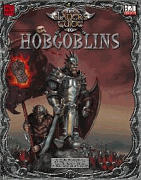
|
About OgreCave and its staff
|

|
by Matthew Pook
As Mongoose Publishing's first release, Hobgoblins is a handsome tome. It comes in the 32-page format common to many Open Game License releases. The cover is rather dark and muddy, but the interior artwork is excellent. In particular, the drawings by Chris Quilliams are striking, particularly his close-ups of Hobgoblin faces and the physiology diagram on the inside front cover. The clear layout of the book is near flawless, with only an occasional, yet minor, typographical error to let the presentation down. In concentrating upon a single race, The Slayer's Guide To Hobgoblins tries to add depth to the DM's portrayal of them in games. In particular, it aims to lift the hobgoblin race from their usual position as D&D cannon fodder. The hobgoblin is the middle cousin of the three-goblinoid races (the others being goblins and bugbears). Where the smaller goblins are erratic, cunning and sneaky, hobgoblins are stronger and disciplined, but not as stealthy. They also have a stronger sense of loyalty to their tribe than a goblin or bugbear would have to theirs. Hobgoblins know that their own survival lies with that of their tribe or war band. The Slayer's Guide To Hobgoblins opens with a piece of colour fiction that illustrates the dangers of underestimating the hobgoblin as a foe. This is backed up by the eyewitness accounts of a scholar researching the hobgoblin in their natural habitat. These could easily be reproduced to give to players whose characters want to research the race themselves. Each aspect of hobgoblins is explored in just about enough depth. This includes their physiology, psychology, where they can be found (which is in a wide array of terrains), their society, religion and claimed origins (which also serves to explain their extreme hatred of all elves). The importance of the tribe is stressed throughout, with the position of warrior paramount and dominating every facet of daily life. Only warriors may become tribal chiefs, and only warriors may declare 'Surka' or tribal challenge. The challenged warriors fight each other until one yields and the dispute is thus settled - there is no loss of face for the yielding warrior. Surka is the only acceptable method of settling disputes within hobgoblin society, with foul play being despised by every hobgoblin. Whilst the hobgoblin race are not technologically adept, preferring to steal or get others to do their work, when the situation calls for it, they will turn to agriculture or animal husbandry in order to feed themselves. Much of the book is devoted to hobgoblins as warriors and as a military force. Constantly highlighted is the fact that hobgoblins are no fools in combat, learning from their own mistakes, and taking advantage of those made by their foes. This applies to both tribal war bands and mercenary hobgoblins that are no longer part of a tribe. Hobgoblins tend to operate as scouts, raiders and ambushers, but they accept the discipline of fighting as a larger unit. They will rally around the tribal banner, which they hold to be a prized possession. Indeed, the two new spells included in The Slayer's Guide To Hobgoblins are particular to hobgoblin use. They can only be cast upon the banner of a war band or mercenary unit, and increase the effectiveness of the hobgoblin upon the field of battle. Only when fighting elves does the impressive hobgoblin discipline sometimes desert them. Six short scenario ideas are given, as well as a guide to hobgoblins as players. This section is short, but the rest of the book gives more detail (in general, it can be said that having both a hobgoblin and an elf in the same party is a bad idea!). The book is rounded out with not an actual scenario, but a situation that can be slotted into an existing campaign. This consists of a frontier fort recently occupied by a hobgoblin tribe, and is an effective illustration of how a tribe works. Each of the main hobgoblin NPCs is detailed for this tribe, in addition to examples of typical hobgoblins. The situation at the fort can be inserted into most games, and should provide a fair amount of gaming time if the DM takes advantage of the book's background. The Slayer's Guide To Hobgoblins is a particularly useful sourcebook if the DM wants more information about them than the Monster Manual provides. Though the game statistics are given for D&D3e, the contents of this book are suitable for any fantasy game that includes the hobgoblin race. The book works hard to give hobgoblins character, building nicely on the minimal existing racial details. Mongoose Publishing is to be commended for producing an attractive and useful book in their first release, and this bodes well for their future books.
|
||
